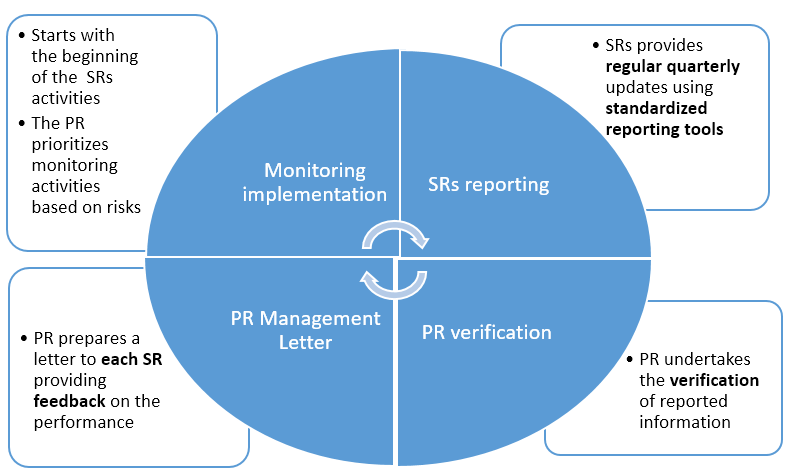-
Functional Areas
- Principal Recipient Start-Up
-
Legal Framework
- Overview
- Project Document
-
The Grant Agreement
- UNDP-Global Fund Grant Regulations
- Grant Confirmation
- Grant Confirmation: Face Sheet
- Grant Confirmation: Conditions
- Grant Confirmation: Conditions Precedent (CP)
- Grant Confirmation: Special Conditions (SCs)
- Grant Confirmation: Schedule 1, Integrated Grant Description
- Grant Confirmation: Schedule 1, Performance Framework
- Grant Confirmation: Schedule 1, Summary Budget
- Implementation Letters and Performance Letters
- Agreements with Sub-recipients
- Agreements with Sub-sub-recipients
- Signing Legal Agreements and Requests for Disbursement
- Language of the Grant Agreement and other Legal Instruments
- Amending Legal Agreements
- Other Legal and Implementation Considerations
- Legal Framework for Other UNDP Support Roles
-
Health Product Management
- Overview - Health Product Management
- UNDP Quality Assurance Policy
- Product Selection
- Quantification and Forecasting
- Supply Planning of Health Products
-
Sourcing and regulatory aspects
- Global Health Procurement Center (GHPC)
- Development of List of Health Products
- Development of the Health Procurement Action Plan (HPAP)
- Health Procurement Architecture
- Local Procurement of health products
- Procurement of Pharmaceutical Products
- Procurement of non-pharmaceutical Health Products
- Other Elements of the UNDP Procurement Architecture
- Submission of GHPC CO Procurement Request Form
- Guidance on donations of health products
- International freight, transit requirements and use of INCOTERMS
- Inspection and Receipt
- Storage
- Inventory Management
- Distribution
- Quality monitoring of health products
- Waste management
- Rational use
- Pharmacovigilance
- Risk Management for PSM of health products
- Compliance with the Global Fund requirements
- UNDP Health PSM Roster
-
Financial Management
- Overview
- Grant-Making and Signing
- Grant Implementation
- Sub-recipient Management
- Grant Reporting
- Grant Closure
- CCM Funding
- Import duties and VAT / sales tax
-
Monitoring and Evaluation
- Overview
- Differentiation Approach
- Monitoring and Evaluation Components of Funding Request
- Monitoring and Evaluation Components of Grant Making
- M&E Components of Grant Implementation
- Sub-Recipient Management
- Grant Reporting
-
Capacity development and transition, strengthening systems for health
- Overview
- Interim Principal Recipient of Global Fund Grants
- A Strategic Approach to Capacity Development
- Resilience and Sustainability
- Legal and Policy Enabling Environment
- Functional Capacities
- Capacity Development and Transition
- Transition
- Capacity Development Objectives and Transition Milestones
- Capacity Development Results - Evidence From Country Experiences
- Capacity development and Transition Planning Process
- Capacity Development and Transition - Lessons Learned
-
Risk Management
- Overview
- Introduction to Risk Management
-
Risk Management in the Global Fund
- Global Fund Risk Management Framework
- Local Fund Agent
- Challenging Operating Environment (COE) Policy
- Additional Safeguard Policy
- Global Fund Risk Management Requirements for PRs
- Global Fund Risk Management Requirements During Funding Request
- Global Fund Review of Risk Management During Grant Implementation
- Risk management in UNDP
- Risk Management in UNDP-managed Global Fund projects
- UNDP Risk Management Process
- Risk management in crisis settings
- Audit and Investigations
- Human rights, key populations and gender
- Human resources
-
Grant closure
- Overview
- Terminology and Scenarios for Grant Closure Process
-
Steps of Grant Closure Process
- 1. Global Fund Notification Letter 'Guidance on Grant Closure'
- 2. Preparation and Submission of Grant Close-Out Plan and Budget
- 3. Global Fund Approval of Grant Close-Out Plan
- 4. Implementation of Close-Out Plan and Completion of Final Global Fund Requirements (Grant Closure Period)
- 5. Operational Closure of Project
- 6. Financial Closure of Project
- 7. Documentation of Grant Closure with Global Fund Grant Closure Letter
Cycle of Sub-recipient Monitoring

- Monitoring implementation: The cycle of Sub-recipient (SR) performance monitoring starts with the beginning of the activities implemented by the SR. The Principal Recipient (PR) should adopt a risk-based approach to prioritize the SRs, sites and activities to supervise based on the SR assessment, the importance of a site in regard to project performance, volume of funds and/or commodities managed by an SR and the risk related to the implementation of a specific activity. Following each monitoring activity, the PR should provide feedback in order to allow timely correction and improve implementation.
- SR reporting: SRs provide regular quarterly updates using standardized reporting tools to record the programmatic and financial achievement of the quarter.
- PR verification: As the third step, the PR undertakes the verification of reported financial information, inventory of health commodities (where applicable) and programmatic results. The verification is a team effort and part of it can take place on PR premises (reviewing the supporting documentation provided by SRs) and, if required, at the SR’s office according to the process previously described. The PMU should plan the data verification within a week after reception of the SR report to allow timely reporting of the PR to the Global Fund. Each Programme Management Unit (PMU) unit works with its contact person at SR level.
-
PR Management Letter: It is good practice, after review and verification of SR reports, for the PR to prepare a letter to each SR providing feedback on the SR’s performance during the reporting period. The letter will also provide information about the disbursement amount for the next period. This Management Letter (English / French / Spanish) should be prepared and sent to the SR after the submission of the SRs programmatic and financial reports, after all information is verified and finalized. The PR will inform the SR about:
- Status of management actions from the previous reporting period(s);
- Management issues identified during the reporting period; and
- Corrective actions required to address observed issues including deadlines.
Author: UNDP UNDP Sharepoint Language: Spanish Type: Tools, Templates and Forms Topic: Managing sub-recipients
Author: UNDP UNDP Sharepoint Language: French Type: Tools, Templates and Forms Topic: Managing sub-recipients
Author: UNDP UNDP Sharepoint Language: English Type: Tools, Templates and Forms Topic: Managing sub-recipients